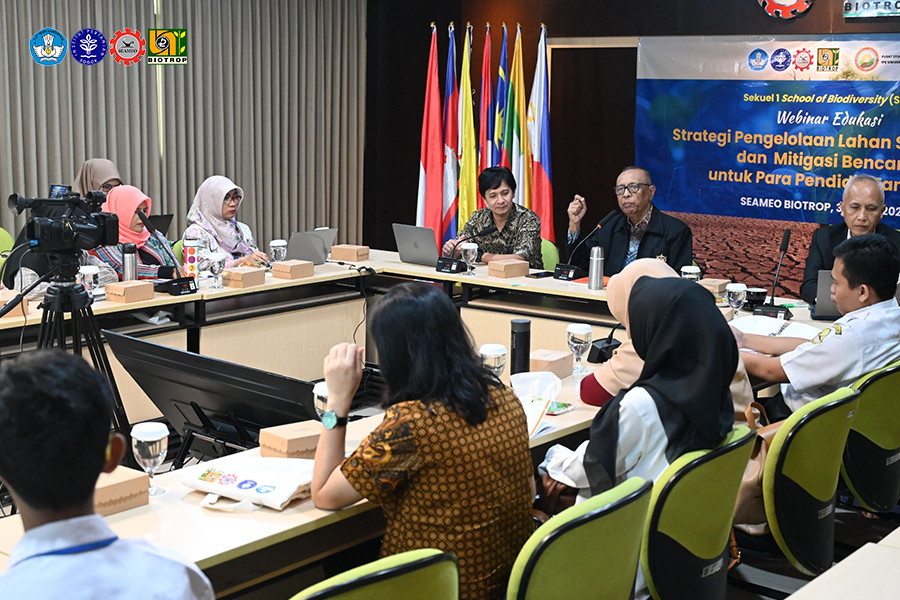Bogor, 30 April 2025 — As part of the School of Biodiversity (SoB) initiative, SEAMEO BIOTROP hosted “"Sequel 1 of the School of Biodiversity (SoB): Educational Webinar on Strategies for Managing Suboptimal Land & Disaster Mitigation for Resilient Educators",” attracting 172 participants from diverse educational backgrounds across Indonesia. This initiative aimed to strengthen educators’ ecological literacy and disaster preparedness through science-based, locally relevant strategies.
Attendees included teachers, lecturers, government officials, and community educators from institutions such as Universitas Padjadjaran, SD Negeri 67 Krui, and SMKN 1 Pulau Laut Barat.
Dr. Elis Rosdiawati, Acting Director of SEAMEO BIOTROP, opened the event by emphasizing the urgency of managing over 33 million hectares of suboptimal land in Indonesia. These include peatlands, tidal swamps, and acid drylands—areas highly vulnerable to degradation and disasters. She called for sustainable land-use practices led by well-informed educators.
Putra Asga Elevri from the Ministry of Education reinforced this message, noting that educators are pivotal in shaping a resilient, inclusive future generation. He stressed the importance of accessible, inclusive teaching, especially for students with special needs—often the most affected during environmental disasters.
Prof. (Ret.) Syamsul Maarif, former Head of BNPB, presented on “Ecosystem-Based Disaster Risk Reduction Strategies (Eco-DRR).” He called for the integration of disaster resilience and climate adaptation into school curricula through experiential learning and local partnerships, positioning schools as hubs for climate action.
Dr. rer. nat. Doni Yusri S., Deputy Director at SEAMEO BIOTROP and Head of the Disaster Studies Center at IPB University, focused on “The Role of Educators in Disaster and Ecological Education.” He advocated for student-centered, interdisciplinary teaching methods—such as simulations, role-playing, and project-based learning—that cultivate both environmental awareness and 21st-century skills.
Risa Rosita, M.Si., Manager of Science and Technology Innovation Department (SITD) of SEAMEO BIOTROP delivered a session titled “Understanding Types of Suboptimal Land in Indonesia: Potential, Risks, and Opportunities for Sustainable Utilization.” Her presentation highlighted how suboptimal lands—covering about 70 million hectares—can serve not just as a challenge but also as a learning resource.
She emphasized the importance of integrating ecosystem-based approaches and applied science into education. Through Teaching Factory (TEFA) programs focused on local biodiversity—such as mushroom cultivation, tissue culture, hydroponics, and essential oils—schools can turn degraded lands into platforms for ecological learning and community resilience.
Risa urged teachers to engage students in contextual, interdisciplinary learning that connects local environmental challenges to real-world solutions. She encouraged activities such as risk mapping, adaptive planting strategies, and agroecology-based conservation projects that empower students to become agents of change.
During the Q&A session, Pak Wiragung from SMAN 1 Citereup raised a practical concern about persistent waterlogging on school grounds. Risa responded that even with biopores and tree planting, poor soil absorption and inadequate drainage design can hinder results. She recommended reassessing biopore placement and depth, selecting more suitable plants, and integrating a functional drainage system.
Moderated by Dr. Harry Imantho (IPB University), the webinar concluded with a call to action for educators to integrate biodiversity and disaster education into school curricula and local initiatives. Through collaborative efforts among schools, research institutions, local governments, and communities, educators can lead the transformation toward a resilient and ecologically responsible future. (hcn, rr, as)
 Thursday, 08 May 2025 on 12:04pm
Thursday, 08 May 2025 on 12:04pm
